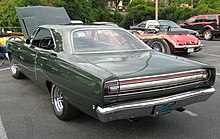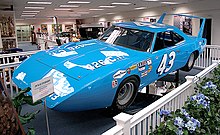Plymouth Road Runner
| Plymouth Road Runner | |
|---|---|
| Production period: | 1967-1980 |
| Class : | Sports car |
| Body versions : | Coupé , convertible |
The Plymouth Road Runner was a car model from the USA that is counted among the muscle cars . Only in model year 1970 there was a rear wing reinforced hardtop variant under the name Plymouth Superbird .
history
Early in 1967 , a journalist for Car and Driver magazine had the idea of building a vehicle that was significantly different from the ones built to date. It should be on the basis of a coupe be developed, equipped with a 440 Super command or 426 Hemi engine (8 cylinders - V-engines ) as a standard engine, front seat and sporty rim; but without unnecessary external changes such as hood scoops (air inlets on the bonnet), stripes (the “rally stripes” popular with muscle cars) or other “gimmicks”. With his idea he turned to Plymouth's development office, where the idea was welcomed but not considered profitable.
After this conversation, however, further considerations were made at Plymouth as to how such a model could be realized with simple but functional equipment, which should primarily appeal to 16-20 year olds.
The decision was made for the cheapest and lightest body variant, the 2-door pillar coupe, i.e. the coupé with a B-pillar based on the Plymouth Belvedere Coupé. The 383-4bbl-V8 (6.3-liter V8 with quadruple carburettor) was set as the standard engine. To increase performance, they wanted to give him cylinder heads and valves from the 440 V8 (7.2 liter V8). However, it turned out in retrospect that this modification only yielded 5 hp more - which was enough to suggest an increase in performance to the buyer.
Once the technical questions had been resolved, the question arose as to which name the new vehicle should have. The choice fell on Road Runner (German: Wegekuckuck ), the name of a fast running bird that lives in the deserts of the southwestern USA. The trigger for the naming was the American cartoon series Road Runner and Wile E. Coyote : One afternoon one of the Plymouth managers and his children saw this series on television and saw the Road Runner racing through the picture. From then on it was clear to him that “Road Runner” should be the name. After the rights had been bought from the Warner Brothers for over $ 50,000 and the bird was thus allowed to be depicted on the cars, they looked for another detail that would remind of the cartoon character. One of the identifying features of the figure was the "beep beep" that the bird let out. So an old military horn was refined to reproduce that sound.
Model year 1968
| 1st generation | |
|---|---|
|
Road Runner Hardtop Coupé, model year 1968 |
|
| Production period: | 1967-1980 |
| Body versions : | Coupé , convertible |
| Engines: |
Gasoline engines : 6.3–7.2 liters (250–317 kW) |
| Length: | 5017 mm |
| Width: | 1849 mm |
| Height: | 1346 mm |
| Wheelbase : | |
| Empty weight : | 1581 kg |
In autumn 1967 the time had come when the first Road Runners left the production line. They were based on the new B-body models and were thus sister models of the Plymouth Belvedere , the Plymouth Satellite and the equally sporty, but better equipped and more expensive Plymouth GTX . The Performance Hood option was available for all these models for an additional charge (image generation 1); here the hood was painted matt black.
This year the cartoon figure was still shown in black and white on the vehicle because there was not enough time for a color version. But that should change in the following years.
After the Road Runner was initially only available as a B-pillar coupé, the hardtop coupé (without B-pillar) was introduced after a while. It was based on the higher-level Plymouth Satellite . However, individual seats were not yet available, nor was a convertible version.
It was powered by the revised 383 engine with 335 hp and 425 ft. Lb. (576 Nm). The standard tires consisted of F70x14 on 14x5½ "rims.
Model year 1969
In 1969 the cartoon characters Road Runner and Wile E. Coyote were then used to advertise the full Plymouth range.
This year, the convertible was added to the coupé and hardtop coupé; the latter remained a rarity with almost 2000 copies. The engines were the same as the previous year, i.e. H. a standard 383 (6.3-liter) and as an option a 426 Hemi-seven-liter with 425 hp and, from spring 1969, a 7.2-liter (440 cui) with three double carburetors, the so-called 440 six-pack. When you ordered these engines, you got the Air Grabber Hood (engine hood with retractable air inlet).
The trade journal Motor Trend found this car so convincing that it awarded the Road Runner the Car of the year award in 1969 .
Model year 1970, Superbird
1970 was actually the last year of the muscle cars, because insurance companies ran storm against the overpowered vehicles, which is why the official performance figures often deviated downwards from the actual values.
In order to upgrade the 1970 model again and because motorsport required it, racing driver Richard Petty was hired without further ado , who insisted on a road runner that was aerodynamically more favorable for the NASCAR oval races. This vehicle plays a supporting role in the animated film Cars .
That was the Plymouth Superbird . With a huge rear wing and an aerodynamic, elongated and flattened front, this should bring the success in the NASCAR racing series that had been denied its predecessor, the Dodge Charger 500 . This goal was achieved, but the Superbird was banned a little later by regulations.
Model year 1971
1971 was the last year of large engines. The insurance companies finally refused to insure these vehicles. After all, the engines in the Chrysler Group still ran on premium gasoline that year, while GM and Ford switched all machines to regular gasoline, and had to accept little or no performance loss compared to the previous year.
The Plymouth mid-range models, including the Road Runner, were given completely new, softer and rounder bodies, which were stylistically very different from the angularity of the 1968-1970 models.
Model years 1972–1974
In 1972 the Road Runner was offered in the "best" configuration with only 250 net hp. Environmental awareness had risen and gasoline was expensive by US standards. The 426 Hemi no longer existed, with the 440 Six-Pack only a handful of copies were created. The Road Runner was built in this form with the usual annual detail changes until 1974.
Model year 1975
In 1975 the Road Runner was based on the newly introduced two-door version of the Fury . The car was a slightly further developed version of the Plymouth Satellite introduced in 1971 and, like this one, used Chrysler's well-known B platform .
Model year 1976
From 1976 the Road Runner was a trim level of the new Plymouth Volare , which replaced the Plymouth Valiant . In 1976 the Road Runner package consisted of a 5.2-liter V8 with 152 hp (5.9-liter with 172 hp on request), sports suspension, three-speed gearbox with center shift and sporty interior equipment. In the 1976 model year, around 7,300 Road Runners were built.
Model year 1977
The Road Runner package included decorative stripes, rally steel rims, sports suspension, black radiator grille and of course the characteristic "beep-beep" horn. 6975 copies rolled off the line. In addition, there were new “Fun Runner” equipment packages based on the Road Runner in the form of the Sun Runner (with sliding roof) and the Front Runner, which was only available in orange with eye-catching decorative stripes. For all Volare there was a T-Roof (removable roof halves) and a sliding roof for an extra charge. In the Road Runner, the 5.2-liter (318 cui) worked with 147 or the 5.9-liter with quadruple carburetor and 177 hp.
Model year 1978
Minor changes to the Road Runner, 5.2-liter now with 142 instead of 147 hp.
Model year 1979
No major changes, the 5.2-liter now only made 137 hp, but the 5.9-liter with four-way carburetor increased to 198 hp. Only 1,122 Volare coupes received the Road Runner package.
Model year 1980
Last year for the Road Runner so no further changes. A total of 496 pieces rolled off the line. With the end of production of the Volare in the summer of 1980, the Road Runner disappeared from the Plymouth program.
swell
- Flammang, James M./Kowalke, Ron: Standard Catalog of American Cars 1976-1999. Kraus Publications, Iola 1999. ISBN 0-87341-755-0
- Genat, Robert / Newhardt, David: Fifty Years of Muscle Cars. Chrysler Plymouth Dodge. Heel Verlag, Königswinter 2004. ISBN 3-898-80490-9







